Hydrothermal Factors Influence on Spatial-Temporal Variation of Evapotranspiration-Precipitation Coupling over Climate Transition Zone of North China
Abstract
:1. Introduction
2. Data and Methods
2.1. Study Area and Sites
2.2. Data
2.3. Methods
2.3.1. Evapotranspiration-Precipitation Coupling Strength
2.3.2. Lifting Condensation Level
2.4. Validation of CCI Soil Moisture
3. Results
3.1. Spatial and Temporal Variation of Evapotranspiration-Precipitation Coupling Strength
3.2. Spatial and Temporal Variation of Evapotranspiration-Precipitation Coupling in Relation to Moisture and Thermal Conditions
3.2.1. Spatial Variation of CS in Relation to Spatial Moisture and Thermal Conditions
3.2.2. Temporal Variation of CS in Relation to Hydrothermal Conditions
Inner-Annual Variability
Inter-Annual Variability
3.3. Reasons of Spatial Differences in Coupling Strength
4. Discussion
4.1. Determination of Water and Temperature Factors via Spatial Pattern of CS
4.2. Determination of Water and Temperature Factors on Temporal Variation of CS
4.3. Positive and Negative Coupling Mechanisms
5. Conclusions
Author Contributions
Funding
Institutional Review Board Statement
Informed Consent Statement
Data Availability Statement
Conflicts of Interest
References
- Huang, R. Progresses in Research on the Formation Mechanism and Prediction Theory of Severe Climatic Disasters in China. Adv. Earth Sci. 2006, 21, 564–575. [Google Scholar]
- Seneviratne, S.I.; Lüthi, D.; Litschi, M.; Schär, C. Land–atmosphere coupling and climate change in Europe. Nature 2006, 443, 205–209. [Google Scholar] [CrossRef] [PubMed]
- Zhang, J.; Wu, L. Land-atmosphere coupling amplifies hot extremes over China. Chin. Sci. Bull. 2011, 56, 1905–1909. [Google Scholar] [CrossRef] [Green Version]
- Zhou, S.; Williams, A.P.; Berg, A.M.; Cook, B.I.; Zhang, Y.; Hagemann, S.; Lorenz, R.; Seneviratne, S.I.; Gentine, P. Land-atmosphere feedbacks exacerbate concurrent soil drought and atmospheric aridity. Proc. Natl. Acad. Sci. USA 2019, 116, 18848–18853. [Google Scholar] [CrossRef] [PubMed] [Green Version]
- Koster, R.D. Regions of Strong Coupling Between Soil Moisture and Precipitation. Science 2004, 305, 1138–1140. [Google Scholar] [CrossRef] [PubMed] [Green Version]
- Zeng, X.; Barlage, M.; Castro, C.; Fling, K. Comparison of Land–Precipitation Coupling Strength Using Observations and Models. J. Hydrometeorol. 2010, 11, 979–994. [Google Scholar] [CrossRef] [Green Version]
- Dirmeyer, P.A. The terrestrial segment of soil moisture-climate coupling. Geophys. Res. Lett. 2011, 38, L16702. [Google Scholar] [CrossRef]
- Koster, R.D.; Sud, Y.C.; Guo, Z.; Dirmeyer, P.A.; Bonan, G.; Oleson, K.W.; Chan, E.; Verseghy, D.; Cox, P.; Davies, H.; et al. GLACE: The Global Land–Atmosphere Coupling Experiment. Part I: Overview. J. Hydrometeorol. 2006, 7, 590–610. [Google Scholar] [CrossRef]
- Chen, H.; Zhou, J. Impact of Interannual Soil Moisture Anomaly on Simulation of Extreme Climate Events in China.Part II: Sensitivity Experiment Analysis. Chin. J. Atmos. Sci. 2013, 37, 1–13. [Google Scholar]
- Guo, W.; Ma, Z.; Yao, Y. Regional Characteristics of Soil Moisture Evolution in Northern China over Recent 50 Years. Acta. Geogr. Sin. 2003, 58, 83–90. [Google Scholar]
- Williams, I.N.; Torn, M.S. Vegetation controls on surface heat flux partitioning, and land-atmosphere coupling. Geophys. Res. Lett. 2015, 42, 9416–9424. [Google Scholar] [CrossRef]
- Weiqiang, M.; Yaoming, M.; Hirohiko, I. Evaluation of the SEBS for upscaling the evapotranspiration based on in-situ observations over the Tibetan Plateau. Atmos. Res. 2014, 138, 91–97. [Google Scholar]
- Seneviratne, S.I.; Corti, T.; Davin, E.L.; Hirschi, M.; Jaeger, E.B.; Lehner, I.; Orlowsky, B.; Teuling, A.J. Investigating soil moisture–climate interactions in a changing climate: A review. Earth-Sci. Rev. 2010, 99, 125–161. [Google Scholar] [CrossRef]
- Eltahir, E.A.B.; Bras, R.L. Precipitation recycling. Rev. Geophys. 1996, 34, 367–378. [Google Scholar] [CrossRef]
- Wei, J.; Dirmeyer, P.A.; Guo, Z. How Much Do Different Land Models Matter for Climate Simulation? Part II: A Decomposed View of the Land–Atmosphere Coupling Strength. J. Clim. 2010, 23, 3135–3145. [Google Scholar] [CrossRef]
- Goessling, H.F.; Reick, C.H. What do moisture recycling estimates tell us? Exploring the extreme case of non-evaporating continents. Hydrol. Earth Syst. Sci. 2011, 15, 3217–3235. [Google Scholar] [CrossRef] [Green Version]
- Gao, C.; Chen, H.; Li, G.; Ma, H.; Li, X.; Long, S.; Xu, B.; Li, X.; Zeng, X.; Yan, H.; et al. Land–atmosphere interaction over the Indo-China Peninsula during spring and its effect on the following summer climate over the Yangtze River basin. Clim. Dyn. 2019, 53, 6181–6198. [Google Scholar] [CrossRef]
- Findell, K.L.; Eltahir, E.A.B. Atmospheric Controls on Soil Moisture–Boundary Layer Interactions. Part II: Feedbacks within the Continental United States. J. Hydrometeorol. 2003, 4, 570–583. [Google Scholar] [CrossRef]
- Berg, A.; Findell, K.; Lintner, B.R.; Gentine, P.; Kerr, C. Precipitation Sensitivity to Surface Heat Fluxes over North America in Reanalysis and Model Data. J. Hydrometeorol. 2013, 14, 722–743. [Google Scholar] [CrossRef] [Green Version]
- Santanello, J.A.; Dirmeyer, P.A.; Ferguson, C.R.; Findell, K.L.; Tawfik, A.B.; Berg, A.; Ek, M.; Gentine, P.; Guillod, B.P.; van Heerwaarden, C.; et al. Land–Atmosphere Interactions: The LoCo Perspective. Bull. Am. Meteorol. Soc. 2018, 99, 1253–1272. [Google Scholar] [CrossRef]
- Ma, Y.; Yao, T.; Hu, Z.; Wang, J. The Cooperative Study on Energy and Water Cycle over the Tibetan Plateau. Adv. Earth Sci. 2009, 24, 1280. [Google Scholar]
- Yang, Z.; Zhang, Q.; Hao, X.; Yue, P. Changes in Evapotranspiration Over Global Semiarid Regions 1984–2013. J. Geophys. Res. Atmos. 2019, 124, 2946–2963. [Google Scholar] [CrossRef]
- Zhang, Q.; Yang, Z.; Hao, X.; Yue, P. Conversion features of evapotranspiration responding to climate warming in transitional climate regions in northern China. Clim. Dyn. 2019, 52, 3891–3903. [Google Scholar] [CrossRef]
- Findell, K.L.; Eltahir, E.A.B. Atmospheric Controls on Soil Moisture–Boundary Layer Interactions. Part I: Framework Development. J. Hydrometeorol. 2003, 4, 552–569. [Google Scholar] [CrossRef]
- Guillod, B.P.; Orlowsky, B.; Miralles, D.G.; Teuling, A.J.; Seneviratne, S.I. Reconciling spatial and temporal soil moisture effects on afternoon rainfall. Nat. Commun. 2015, 6, 6443. [Google Scholar] [CrossRef]
- Petrova, I.Y.; van Heerwaarden, C.C.; Hohenegger, C.; Guichard, F. Regional co-variability of spatial and temporal soil moisture–precipitation coupling in North Africa: An observational perspective. Hydrol. Earth Syst. Sci. 2018, 22, 3275–3294. [Google Scholar] [CrossRef] [Green Version]
- Luan, L.; Meng, X.; Lv, S.; Han, B.; Li, Z.; Zhao, L.; Li, R. Simulation on Afternoon Convective Precipitation Triggered by Soil Moisture over the Qinghai-Tibetan Plateau. Plateau Meteorol. 2018, 37, 873–885. [Google Scholar]
- Ford, T.W.; Rapp, A.D.; Quiring, S.M.; Blake, J. Soil moisture–precipitation coupling: Observations from the Oklahoma Mesonet and underlying physical mechanisms. Hydrol. Earth Syst. Sci. 2015, 19, 3617–3631. [Google Scholar] [CrossRef] [Green Version]
- Dirmeyer, P.A.; Chen, L.; Wu, J.; Shin, C.S.; Huang, B.; Cash, B.A.; Bosilovich, M.G.; Mahanama, S.; Koster, R.D.; Santanello, J.A.; et al. Verification of land-atmosphere coupling in forecast models, reanalyses and land surface models using flux site observations. J. Hydrometeorol. 2018, 19, 375–392. [Google Scholar] [CrossRef]
- Wei, J.; Dirmeyer, P.A. Dissecting soil moisture-precipitation coupling. Geophys. Res. Lett. 2012, 39, L19711. [Google Scholar] [CrossRef]
- Guo, Z.; Dirmeyer, P.A. Interannual Variability of Land–Atmosphere Coupling Strength. J. Hydrometeorol. 2013, 14, 1636–1646. [Google Scholar] [CrossRef]
- Phillips, T.J.; Klein, S.A. Land-atmosphere coupling manifested in warm-season observations on the U.S. southern great plains. J. Geophys. Res. Atmos. 2014, 119, 509–528. [Google Scholar] [CrossRef]
- Ruscica, R.C.; Sörensson, A.A.; Menéndez, C.G. Pathways between soil moisture and precipitation in southeastern South America. Atmos. Sci. Lett. 2015, 16, 267–272. [Google Scholar] [CrossRef] [Green Version]
- Ruscica, R.C.; Menéndez, C.G.; Sörensson, A.A. Land surface–atmosphere interaction in future South American climate using a multi-model ensemble. Atmos. Sci. Lett. 2016, 17, 141–147. [Google Scholar] [CrossRef] [Green Version]
- Li, M.; Ma, Z.; Gu, H.; Yang, Q.; Zheng, Z. Production of a combined land surface data set and its use to assess land-atmosphere coupling in China. J. Geophys. Res. Atmos. 2017, 122, 948–965. [Google Scholar] [CrossRef]
- Gao, C.; Chen, H.; Sun, S.; Xu, B.; Ongoma, V.; Zhu, S.; Ma, H.; Li, X. Regional Features and Seasonality of Land–Atmosphere Coupling over Eastern China. Adv. Atmos. Sci. 2018, 35, 689–701. [Google Scholar] [CrossRef]
- Genhou, S.; Zeyong, H.; Yaoming, M.; Zhipeng, X.; Fanglin, S.; Jiemin, W.; Song, Y. Analysis of local land atmosphere coupling characteristics over Tibetan Plateau in the dry and rainy seasons using observational data and ERA5. Sci. Total Environ. 2021, 774, 145138. [Google Scholar]
- Zhao, J.; Liu, S. Research on the impact of vegetation change on land-atmosphere coupling strength in northwest China. Chin. J. Geophys. 2015, 58, 47–62. [Google Scholar]
- Zscheischler, J.; Orth, R.; Seneviratne, S.I. A submonthly database for detecting changes in vegetation-atmosphere coupling. Geophys. Res. Lett. 2015, 42, 9816–9824. [Google Scholar] [CrossRef] [Green Version]
- Hobeichi, S.; Abramowitz, G.; Evans, J.; Ukkola, A. Derived Optimal Linear Combination Evapotranspiration (DOLCE): A global gridded synthesis ET estimate. Hydrol. Earth Syst. Sci. 2018, 22, 1317–1336. [Google Scholar] [CrossRef] [Green Version]
- Yang, K.; He, J. China meteorological forcing dataset (1979–2018). In National Tibetan Plateau Data; National Tibetan Plateau Data Center: Beijing, China, 2019. [Google Scholar]
- Gruber, A.; Scanlon, T.; van der Schalie, R.; Wagner, W.; Dorigo, W. Evolution of the ESA CCI Soil Moisture climate data records and their underlying merging methodology. Earth Syst. Sci. Data 2019, 11, 717–739. [Google Scholar] [CrossRef] [Green Version]
- Dorigo, W.A.; Gruber, A.; De Jeu, R.A.M.; Wagner, W.; Stacke, T.; Loew, A.; Albergel, C.; Brocca, L.; Chung, D.; Parinussa, R.M.; et al. Evaluation of the ESA CCI soil moisture product using ground-based observations. Remote Sens. Environ. Interdiscip. J. 2015, 162, 380–395. [Google Scholar] [CrossRef]
- Ma, S.; Zhu, K.; Li, M.; Ma, Z. A Comparative Study of Multi-source Soil Moisture Data for China’s Regions. Clim. Environ. Res. 2016, 21, 121–133. [Google Scholar]
- Lo, M.-H.; Wu, W.-Y.; Tang, L.I.; Ryu, D.; Rashid, M.; Wu, R.-J. Temporal Changes in Land Surface Coupling Strength: An Example in a Semi-Arid Region of Australia. J. Clim. 2021, 34, 1503–1513. [Google Scholar] [CrossRef]
- Wei, J.; Zhao, J.; Chen, H.; Liang, X.-Z. Coupling Between Land Surface Fluxes and Lifting Condensation Level: Mechanisms and Sensitivity to Model Physics Parameterizations. J. Geophys. Res. Atmos. 2021, 126, e2020JD034313. [Google Scholar] [CrossRef]

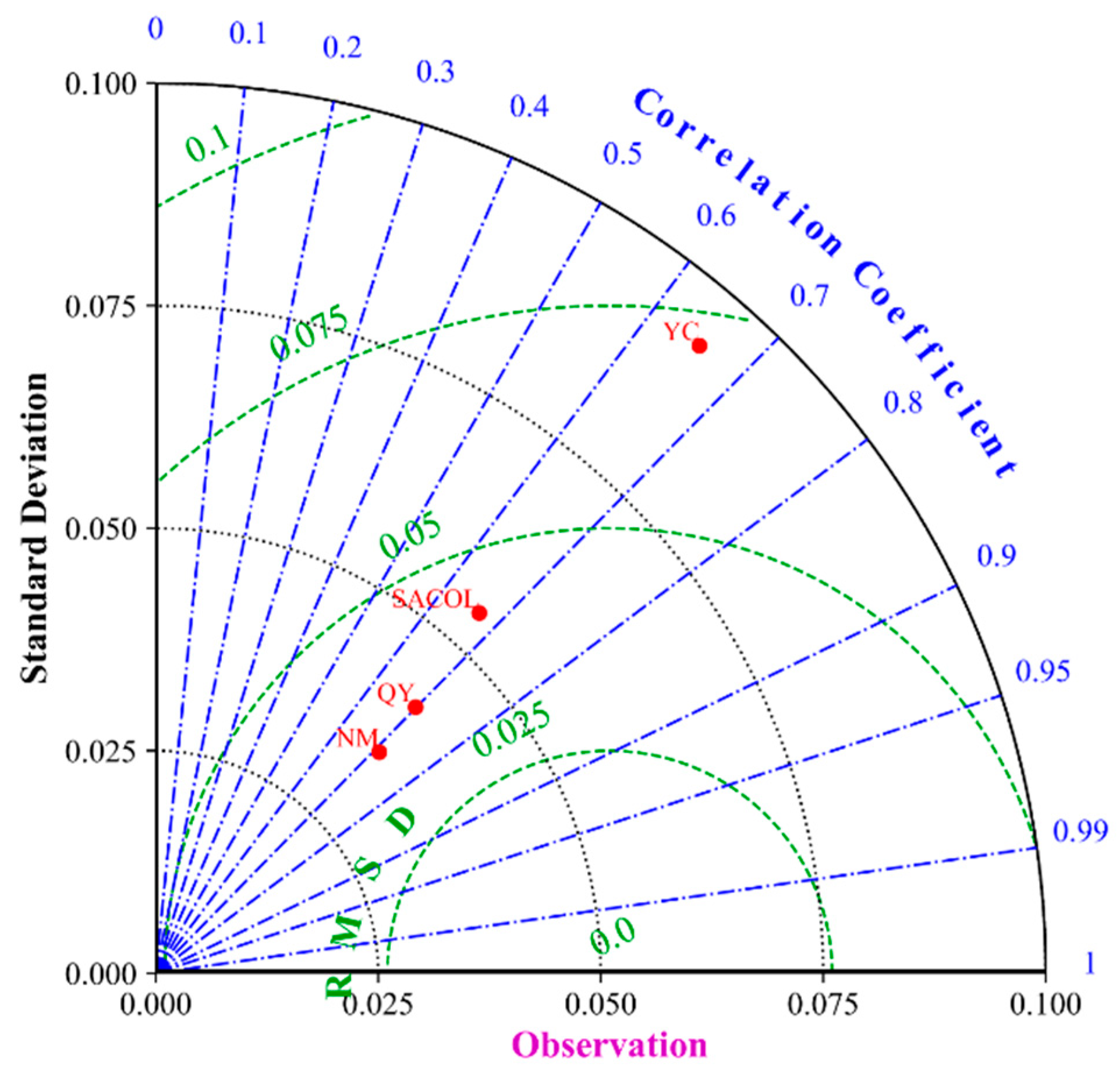
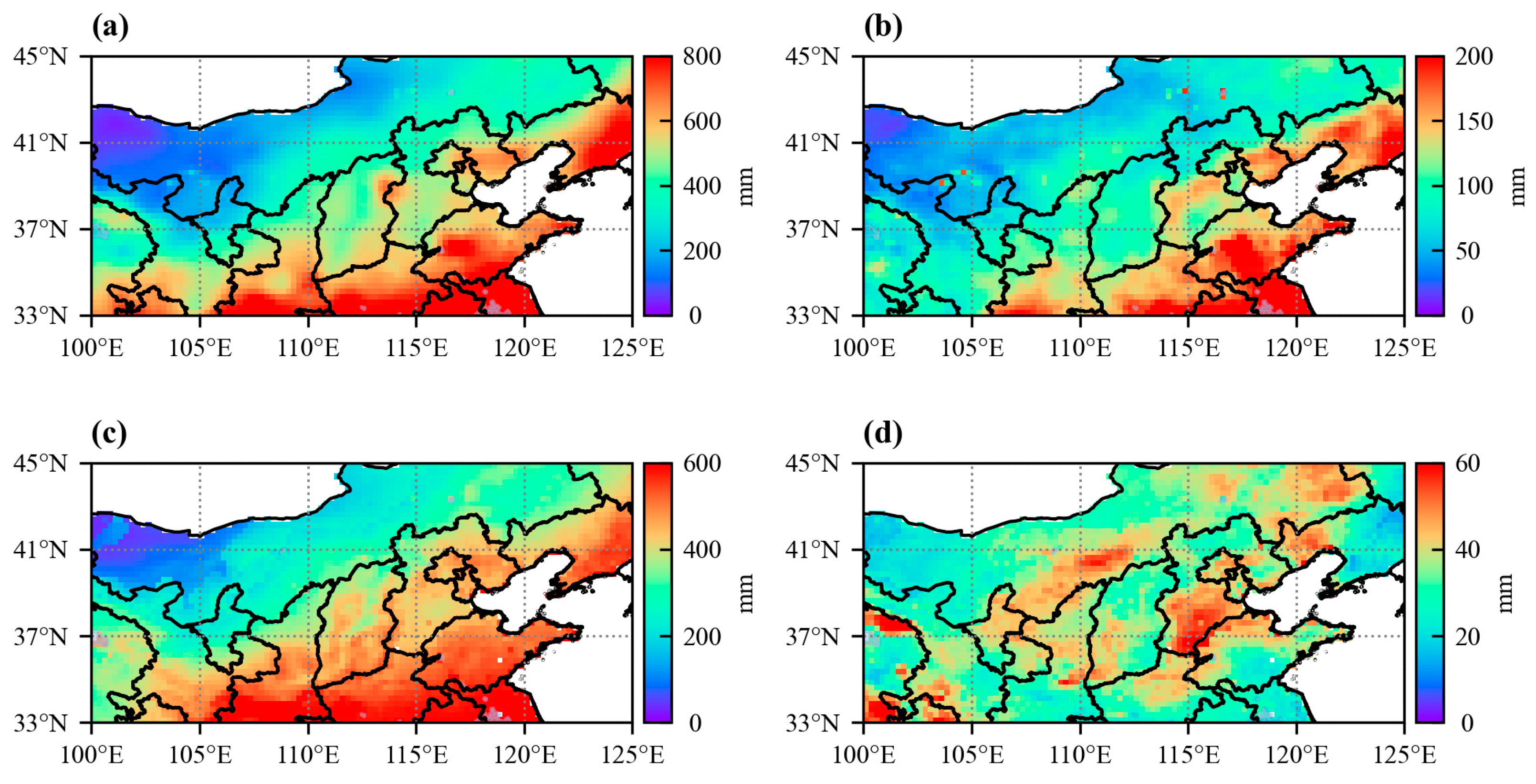
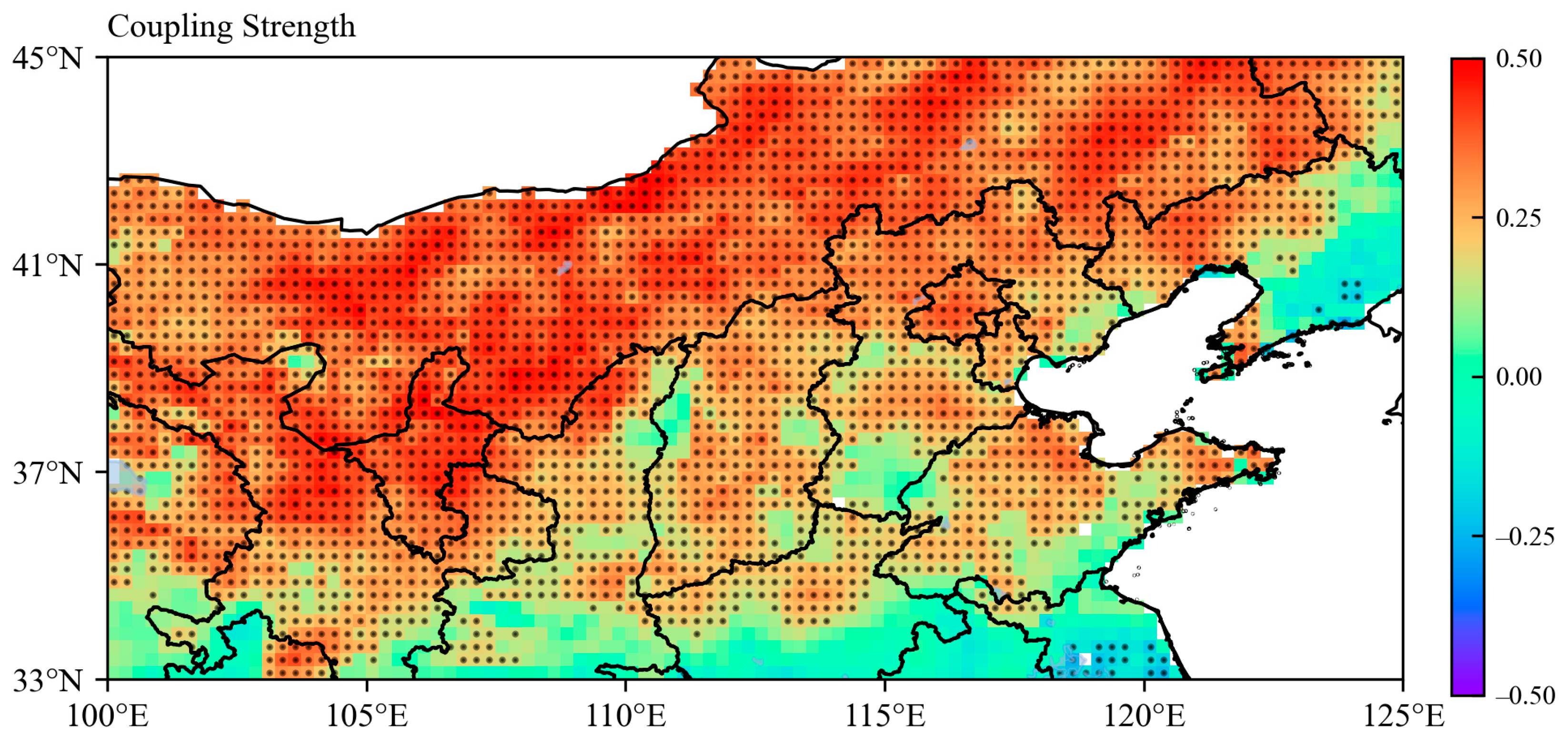

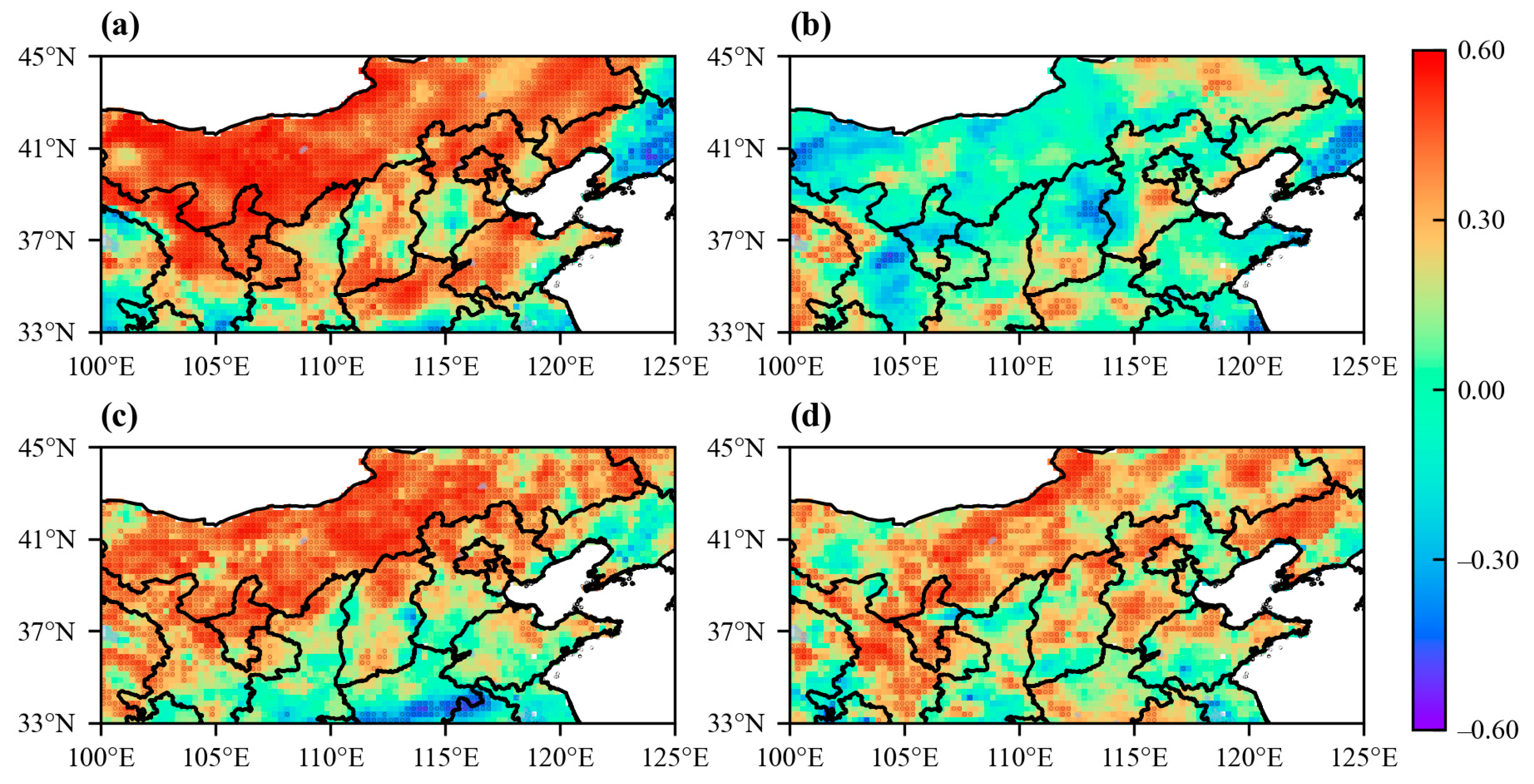
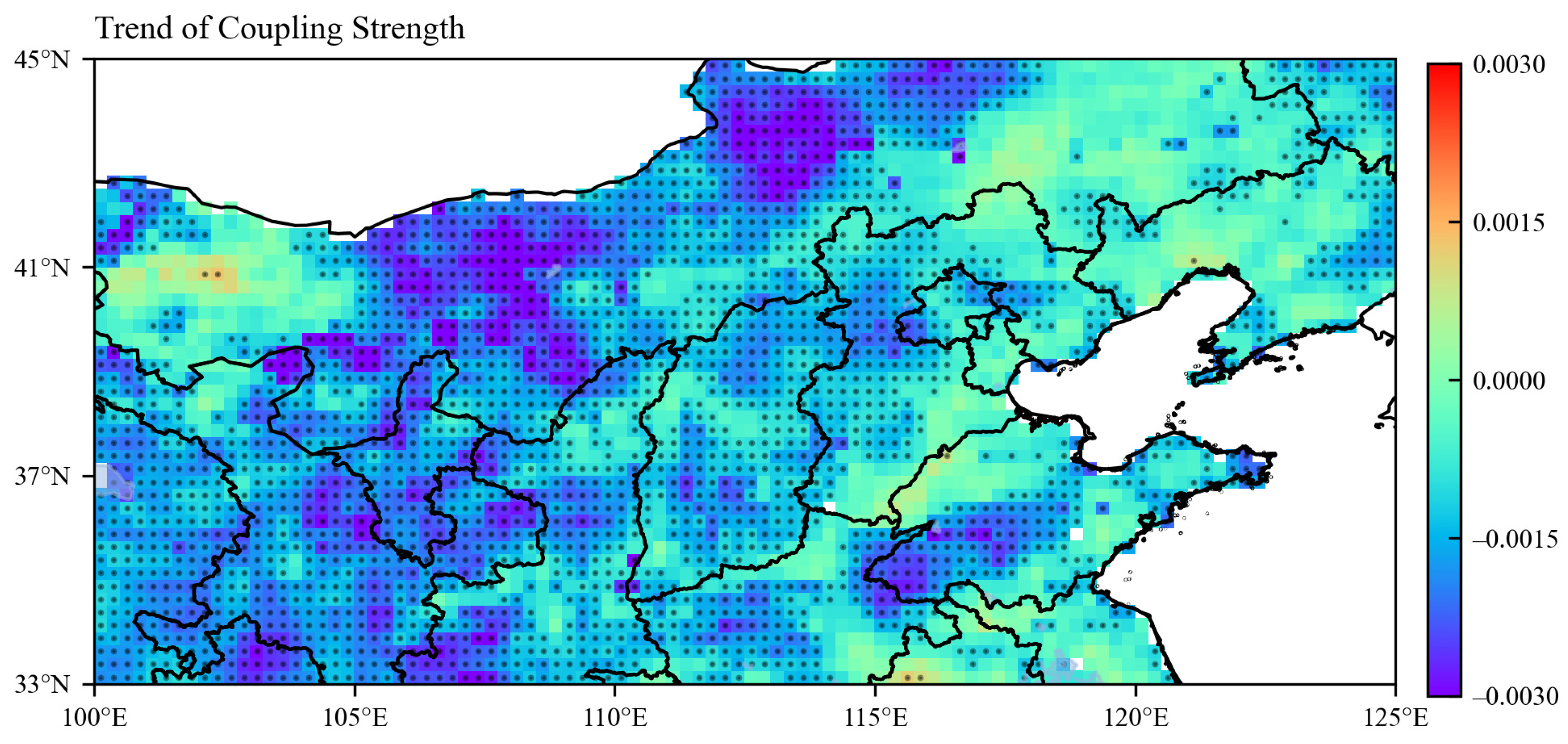
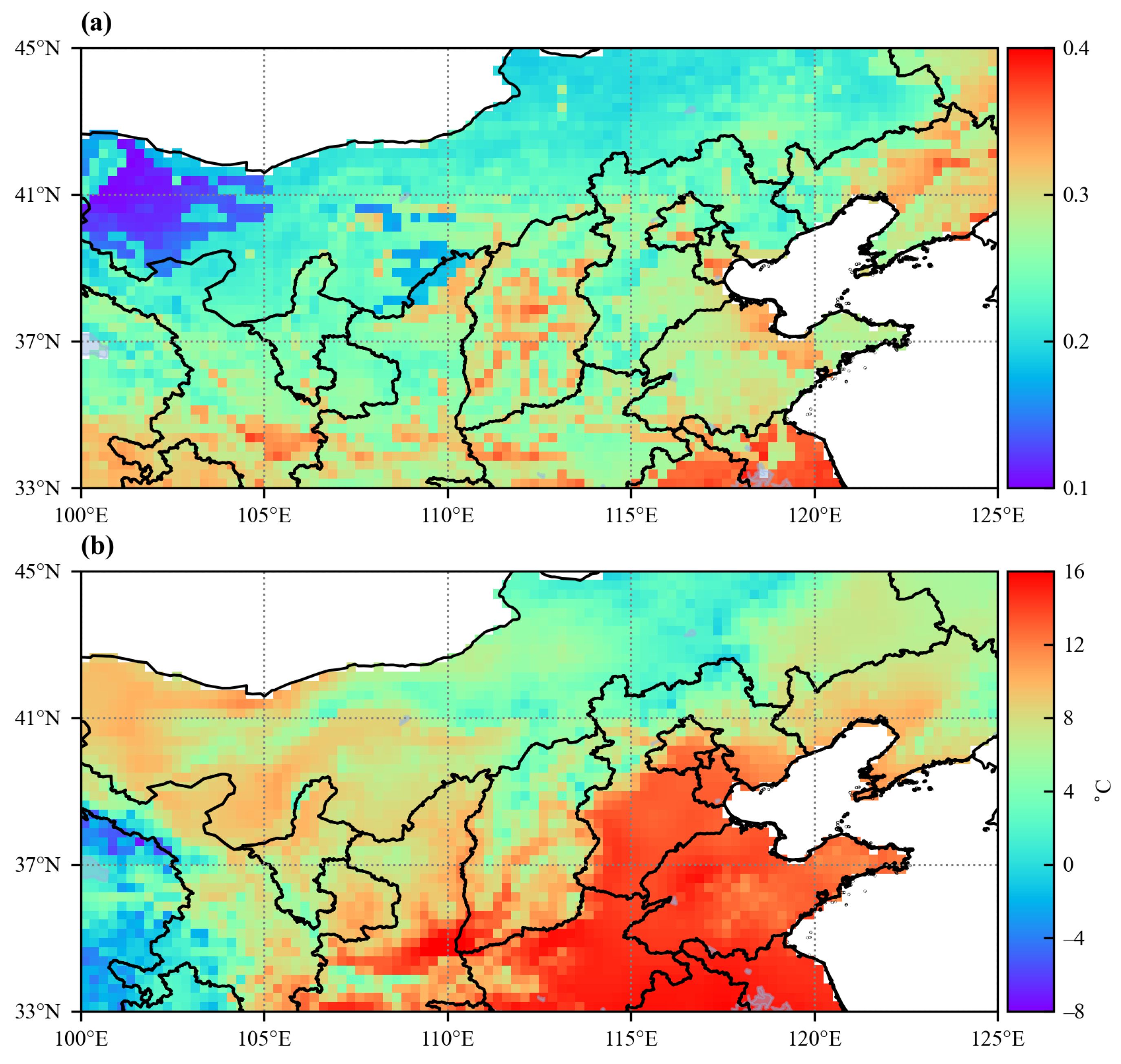
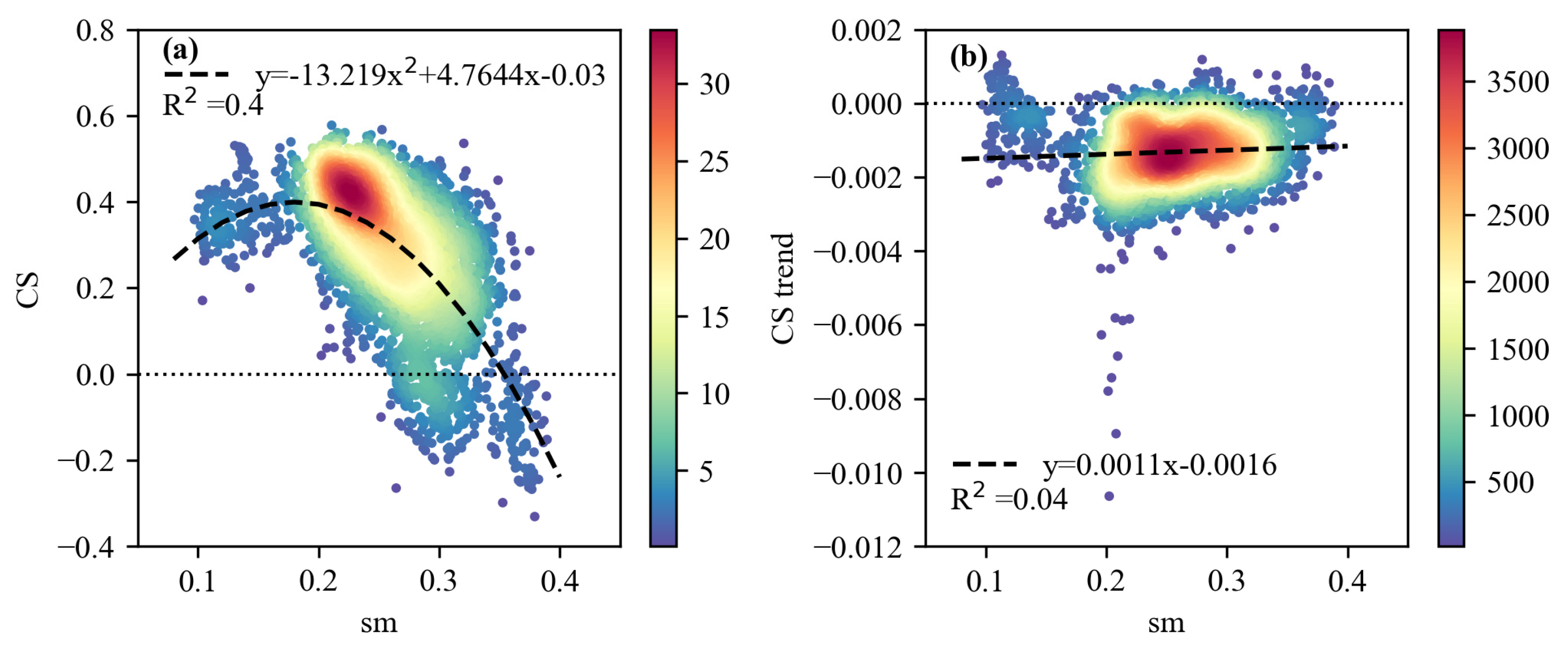

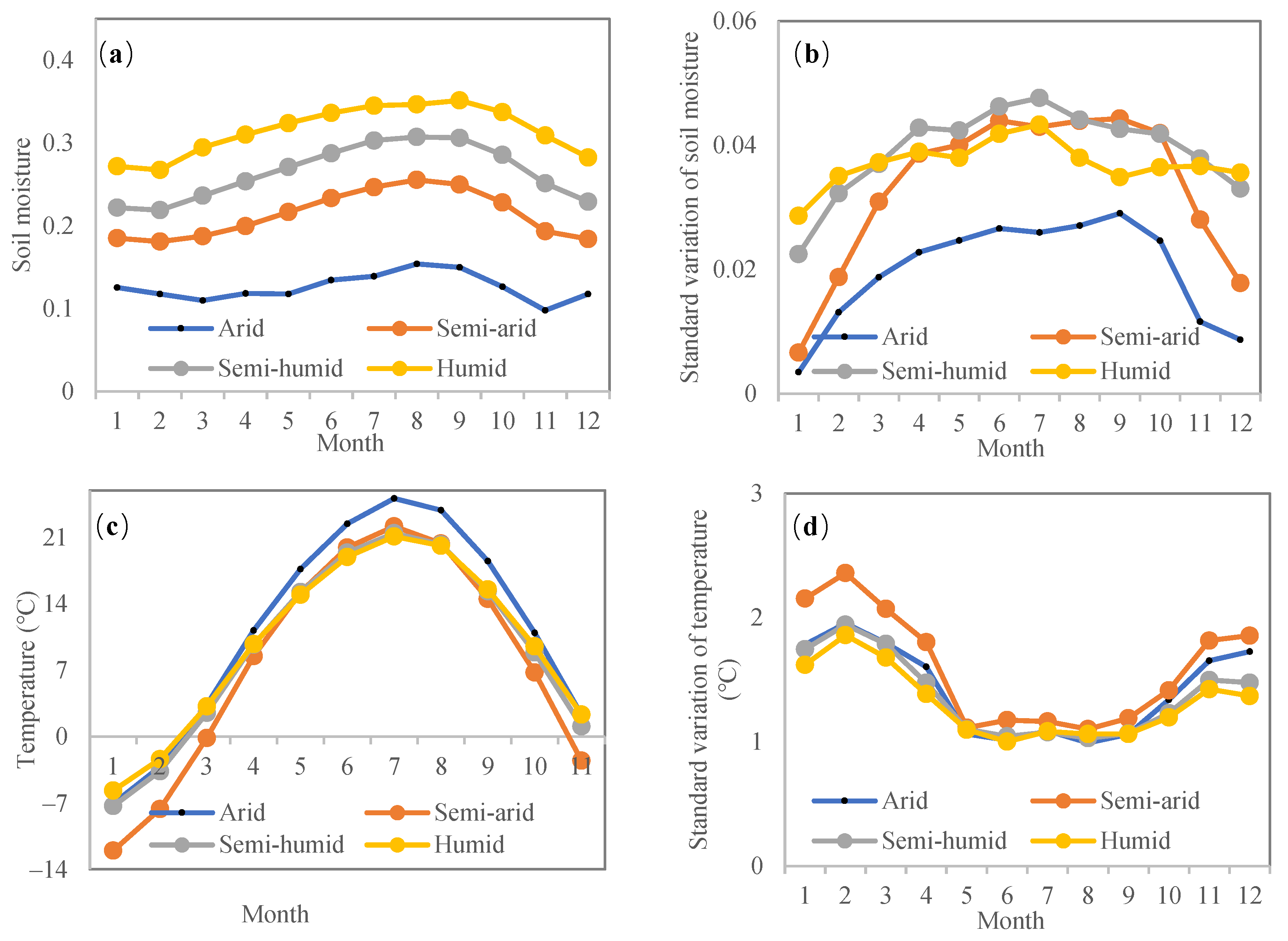
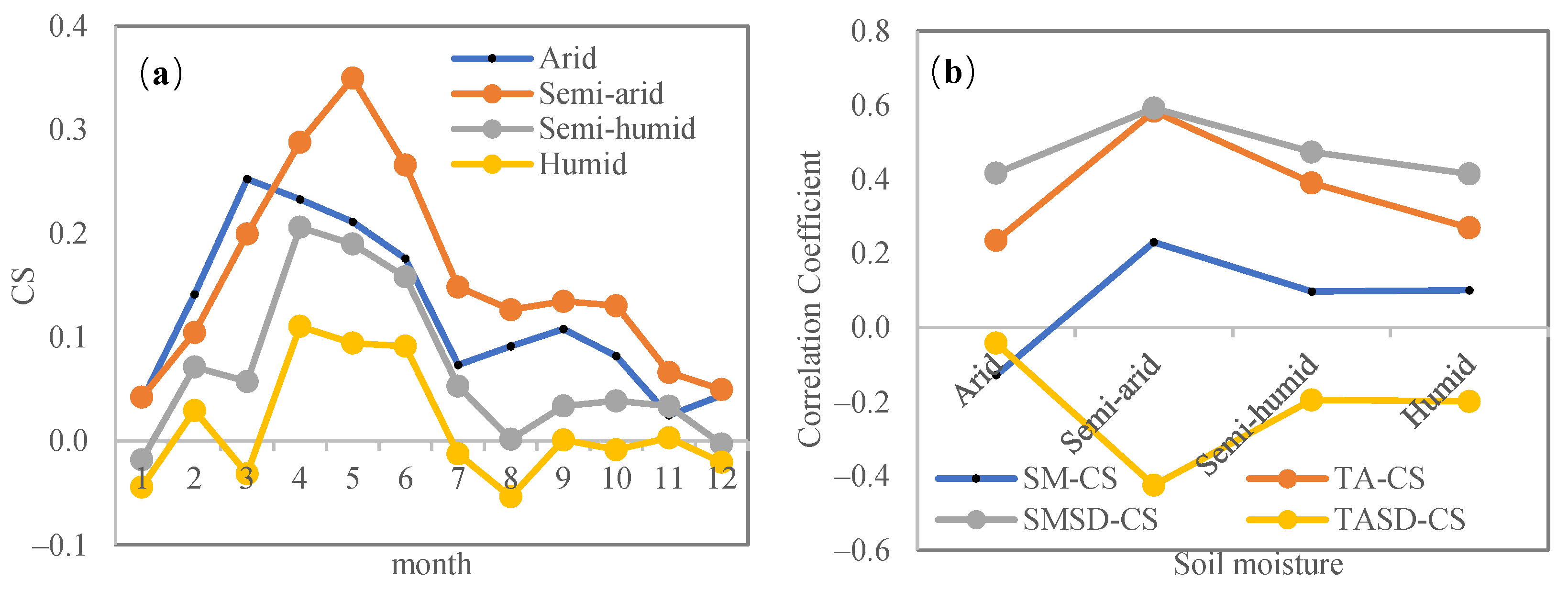
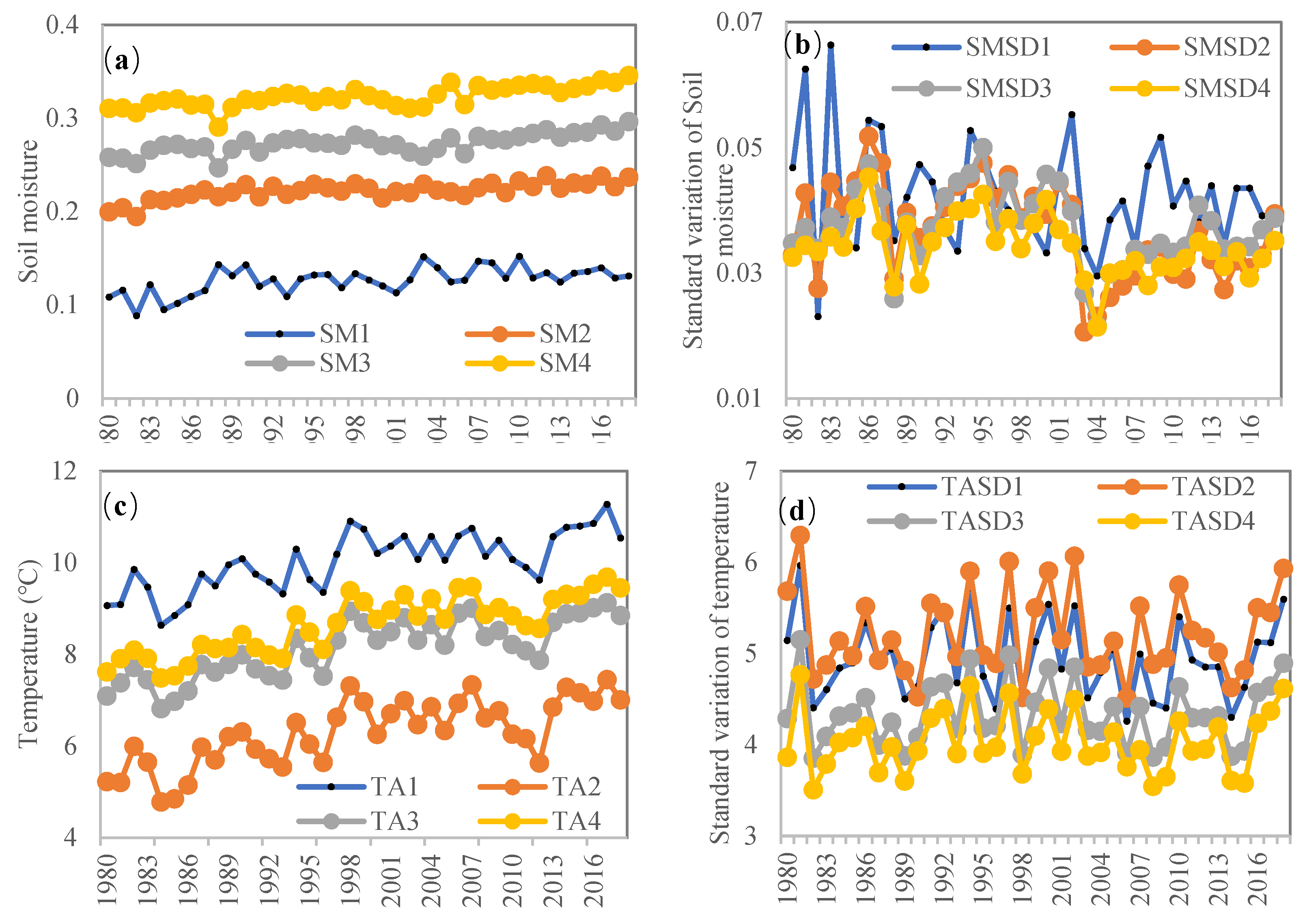

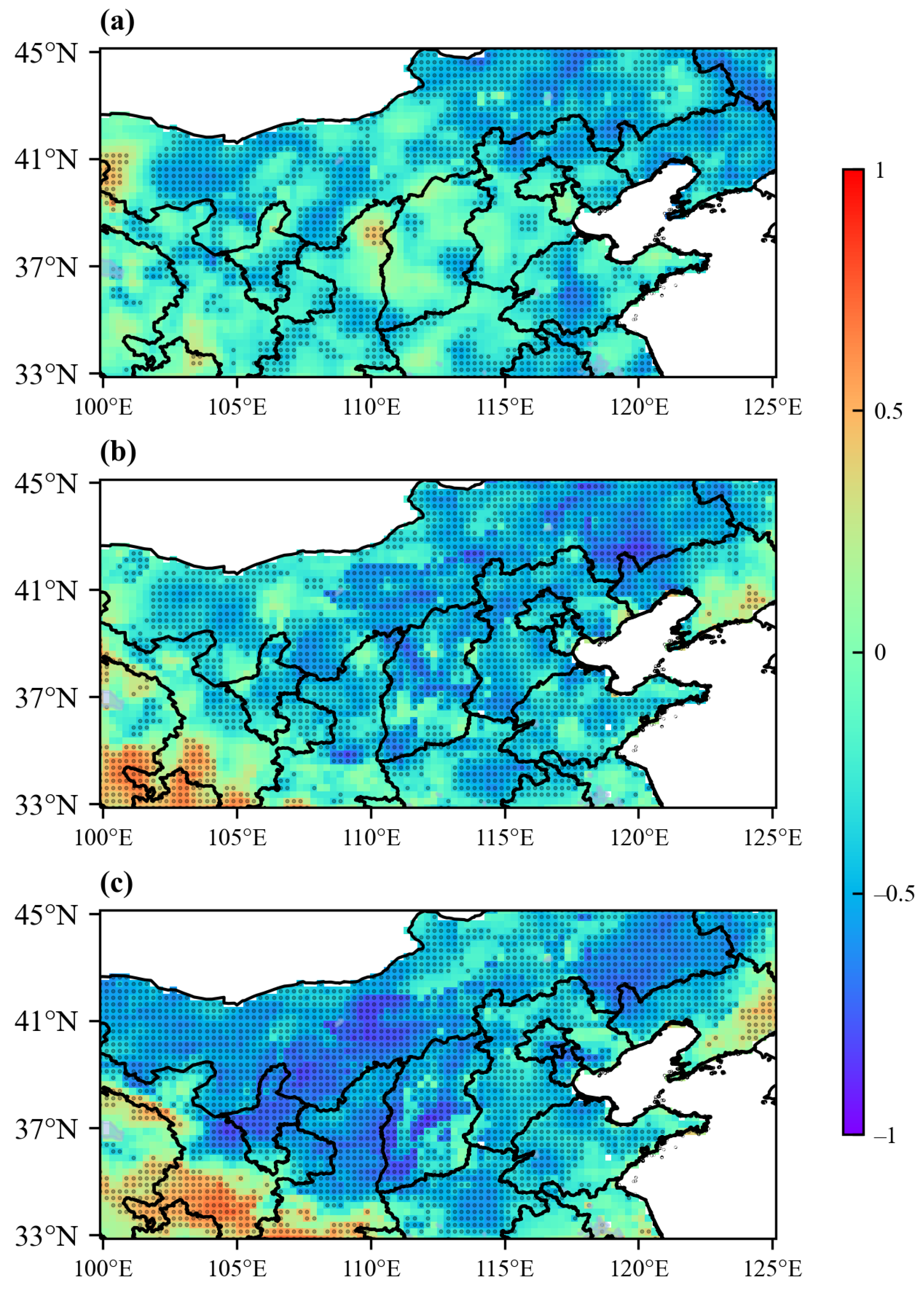
| Station | Location | Elevation (m) | Land Cover | Precipitation (mm) | Mean Air Temperature (°C) | Climate |
|---|---|---|---|---|---|---|
| SACOL | 35°57′N, 104°08′E | 1966 | Grassland | 381.8 | 6.7 | Semi-arid |
| QY | 35°41′N, 107°51′E | 1280 | Cropland | 562 | 8.8 | Sub-humid |
| NM | 43°33′N, 116°40′E | 1250 | Grassland | 336 | 0.8 | Semi-arid |
| YC | 36°50′N, 116°34′E | 28 | Cropland | 582 | 13.1 | Sub-humid |
Publisher’s Note: MDPI stays neutral with regard to jurisdictional claims in published maps and institutional affiliations. |
© 2022 by the authors. Licensee MDPI, Basel, Switzerland. This article is an open access article distributed under the terms and conditions of the Creative Commons Attribution (CC BY) license (https://creativecommons.org/licenses/by/4.0/).
Share and Cite
Yang, Z.; Zhang, Q.; Zhang, Y.; Yue, P.; Zhang, L.; Zeng, J.; Qi, Y. Hydrothermal Factors Influence on Spatial-Temporal Variation of Evapotranspiration-Precipitation Coupling over Climate Transition Zone of North China. Remote Sens. 2022, 14, 1448. https://doi.org/10.3390/rs14061448
Yang Z, Zhang Q, Zhang Y, Yue P, Zhang L, Zeng J, Qi Y. Hydrothermal Factors Influence on Spatial-Temporal Variation of Evapotranspiration-Precipitation Coupling over Climate Transition Zone of North China. Remote Sensing. 2022; 14(6):1448. https://doi.org/10.3390/rs14061448
Chicago/Turabian StyleYang, Zesu, Qiang Zhang, Yu Zhang, Ping Yue, Liang Zhang, Jian Zeng, and Yulei Qi. 2022. "Hydrothermal Factors Influence on Spatial-Temporal Variation of Evapotranspiration-Precipitation Coupling over Climate Transition Zone of North China" Remote Sensing 14, no. 6: 1448. https://doi.org/10.3390/rs14061448







